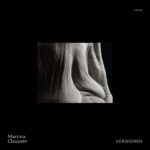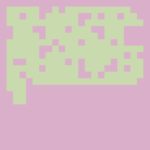MARTINA CLAUSSEN – VERWOBEN 
What to expect from an artist coming from a background of classical vocal performance (such as the Volksoper Vienna, Musikverein and Konzerthaus Vienna), a ‘Professor of Voice’ like Martina Claussen? Easy: an album with the voice as the central instrument, of course.
But Martina Claussen has expanded her artistic practice into electronic music and performance, combining the sound of the human voice with sound objects, field recordings, and analog and digital electronics. Her voice may still be her primary source of expression, but her debut album Verwoben (Interwoven) is an intricate display of electronic and electro-acoustic music.
“Martina’s ambition for Verwoben was to ‘open up a wide variety of associations and new acoustic spaces through a dialogue between voice, sound objects, and electronics’.”
To say she succeeded is an understatement.
Claussen never chooses the easy way: the abstract soundscapes can be somewhat disrupting at times – “there’s both tension and bliss in her digitally manipulated ‘landscape of voices’.
But, “even as the sound moves further and further out into the more shadowy and desolate spaces”, there’s always Martina‘s voice showing the way out.
Or so it seems, anyway: I could not help thinking about the Lorelei saga: the myth of the female siren who, sitting on the cliff above the Rhine and combing her golden hair, unwittingly distracted shipmen with her beauty and song, causing them to crash on the rocks.
ANDRÉE BURELLI – DE SIDERA 
I would be lying if I told you I knew that Andrée Burelli previously performed as Bodyverse, where she used the alias Andy Mintaka. Obviously, this is somewhat confusing, since Discogs only lists this recent album De Sidera under her name, even though her Bandcamp page offers no less than three previous releases – all released from May to October 2020. With promising titles, by the way: How To Survive Difficult Times – Cinematic / Meditation. (Definitely check these out if you want to hear Burelli’s more experimental/minimal approach).
But for now, let’s focus on De Sidera. An Italian native (Venice born), living in Berlin since she was 15, temporarily went back to Sardinia and was “overwhelmed by the beauty of its nature, landscape and cultural roots.” This inspired her to write the music on this album, hence also the Italian titles. The vocals on this album, in the title track and in Cum Sidera, however, are not Italian: it’s an invented, wordless language.
Sometimes the influence of the Italian culture on the music can be plainly heard, such as in Aquilone Perduto, in other tracks this may be somewhat less obvious.
De Sidera is an album full of refreshing ‘pop ambient’ – maybe not ‘ambient’ per definition, but definitely no standard ‘pop’ either. Inspired by the natural wonders that surrounded her, Andrée Burelli combines the two vocal ‘songs’ with loop-based improvisations based on her studies in tabla and Hindustani classical music. As introspective as it is expressive.
CLARICE JENSEN – PLATONIC SOLIDS 
The Longform Editions October batch features a contribution by Clarice Jensen, alongside additions by Claire Rousay, Taylor Deupree and Strategy.
(Longform Editions morphed their typographical layout into a colour variation that is impossible to read, but take it from the that the above image presents the artist name and the album title).
spotify:album:
For those of you interested in trigonometry, the platonic solids may be a familiar concept. Those of you that are not may check the Wikipedia page for an impression (and I may add here that the images speak louder than words, at least to me).
Fascinated by these five shapes, Clarice Jensen wrote graphical scores based on these, “along with the elements of earth, fire, air, water and the quintessence Plato assigned to them.”
Platonic Solids 1 (does that mean there may be four to follow?) is a 25-minute piece that “evokes stasis and movement at the same time”.
Like much of the best ambient music, especially drones, it defies the experience of time. In Clarice’s words: “My regular and deeply embedded sense of rhythm and time is replaced by complete absence, and when I’m brought back to regular rhythm (when the piece is finished), it feels like both (or neither) an eternity and a brief moment have passed.”
This describes exactly what she achieves here: a sense of timelessness. In such a convincing way that I refrained from trying to visualize the five polyhedra in relation to the music.






